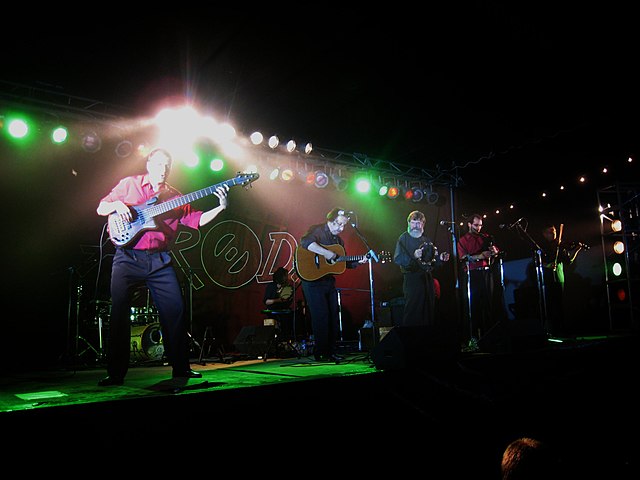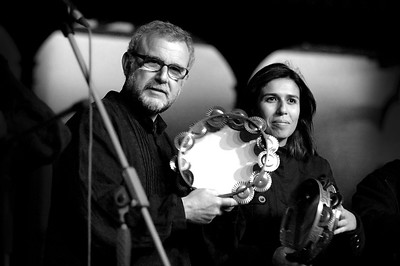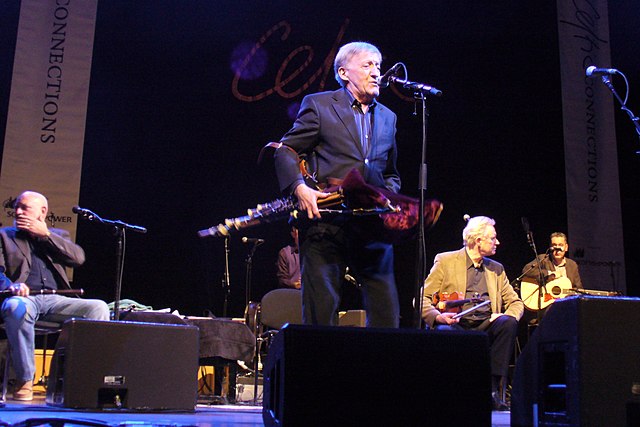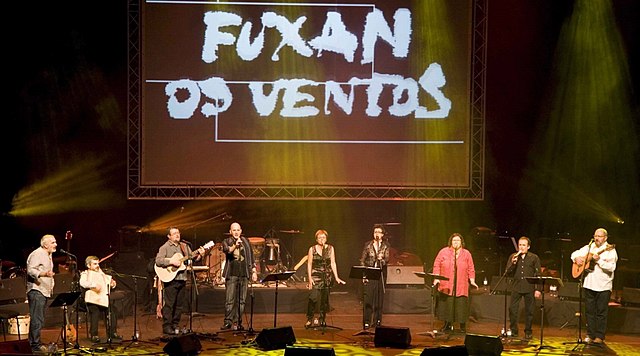A World of Music
LIVE MUSIC 2: A World of Music: Galician and Irish folk music
|
GALICIAN FOLK MUSIC From the first recording of Galician music in 1904 by the choir Aires da Terra, from Pontevedra, till present time many things have happened regarding to music. During the Spanish dictatorship, folk performances were highly politicised, so audience interest in this genre decreased. However, some groups managed to succeed and the beginning of democracy meant the flourishing of folk music. Though there are different opinions about a Galician-Irish common musical origin, it is clear that the end of the 20th century meant a revival for folk music. Bands from Scotland, Ireland, Brittany and Galicia have met in festivals, such as Inter-Celtic Festival of Lorient (since 1971) and Ortigueira's Festival of Celtic World (since 1978), sharing a common musical spirit. |
Fuxan os VentosThey started in 1972 as a group of teenagers who only wanted to sing and enjoy but their success and the contact with their audience during gigs enriched their repertoire with more mature, demanding lyrics. Some musicians have joined in and some others have left the band but its musical quality has always been improving. Some famous songs are: Fuxan os ventos, Sementarei e O meu amor Mariñeiro.
A RodaThey started in 1976 in Vigo as a group of friends who enjoyed singing in taverns. They sang traditional Galician songs such as Pousa, pousa, O andar miudiño e O gato. They helped normalise the use of Galician language during the political period called Transition with their second album called Falemos Galego (1979).  Xosé Calvo. A Roda en concerto en San Mamede de de Carnota. Wikimedia Commons (Public Domain) Xosé Calvo. A Roda en concerto en San Mamede de de Carnota. Wikimedia Commons (Public Domain)
MilladoiroMilladoiro began giving concerts at the end of the 70s in Coruña. They played several instruments depending on the songs, pipes, guitars, mandolin, oboe, violin, percussion, etc. and also instruments which were common in Irish tradition: the uillean pipe, whistle, bouzouki, harp and bodhran. They wanted to fuse Celtic music from Ireland, Scotland and Brittany with Galician traditional melodies. They have released about nineteen albums and got a Goya award for La mitad del Cielo soundtrack. Some of their albums are Galicia no país das Maravillas (1986), Galicia no Tempo (1992) and Atlántico (2018). Luar na lubreThe group started playing in A Coruña in 1986. The became worldwide famous when Mike Oldfield loved the song O son de ar and proposed to go on a tour together. The band has taken interest in Galician history, nature, ethnography as well as music from Portugal. They usually play the pipe, violin, whistle and flute, tambourine, bouzouki, bodhrán, etc. Some of their most famous singles are Memoria da Noite, O son do ar and Chove en Santiago.
José Luís Frías. Sara e Xulio (Luar na Lubre) Flickr. (CC BY-NC)
UxíaThis singer, born in Pontevedra in 1962, is well-known for her distinctive powerful voice. He sings traditional songs as well as medieval tunes. 
Carlos NúñezHe was born in Pontevedra in 1971. He became famous due to his virtuosity playing the pipe. He has sold more than a million copies around the world. His album A Irmandade das Estrelas was a milestone for folk music.
Susana SeivaneShe was born in Barcelona in 1976. She plays the pipe and joins tradition and young tendencies in her music. Her last album was Dende o meu balcón in 2020. 
Richi. Susana Seivane. Flickr. (CC BY-NC-SA)
|
The DublinersThe five members of the band started playing in Dublin in 1962 and became successful. In their fifty years of career, the musicians changed several times but the two lead vocalists remained through years. They performed controversial political songs and were banned in Ireland for some years. They were a great influence for other bands and a milestone in the development of Irish folk music. The ChieftainsThey started playing in 1963 and in the 70s they were already worldwide famous. Their music was only instrumental: a pipe, a bodhrán, a fiddle and a whistle but they are known for collaborating with other musicians as different as Milladoiro and Carlos Núñez or The Rolling Stones or Luciano Pavaroti. One of their albums is Santiago dedicated to the traditional music of Galicia. The Irish government awarded them the title of 'Ireland's Musical Ambassadors' in 1989. 
Candy Schwartz. Paddy Moloney and The Chieftains 2010. Flickr.(CC BY)
Sharon ShannonShe is from County Claire, Ireland (1968). She plays the accordion, melodion, fiddle and tin whistle. She plays traditional Irish music which she fuses with other types of musics. Two of her hits are The Galway Girl and Blackbird. .jpg)
Bryan Ledgard. Sharon Shannon Cambridge Festivals 2001-2014. Wikimedia Commons. (CC BY)
|
|
IRISH FOLK MUSIC Irish folk music ensembles use instruments such as the uillean pipes, fiddles, flutes and whistles, accordion, bodhráin, bouzoukis, banjos and harps. Most songs have got lyrics but some others can be unaccompanied by instruments. Their success rocketed in the second half of the 20th century when their music spread all around Europe and the USA. You can read about famous performers below.
|
Licensed under the Creative Commons Attribution Non-commercial Share Alike License 4.0



